Lewin Benjamin (ed.) Genes IX
Подождите немного. Документ загружается.

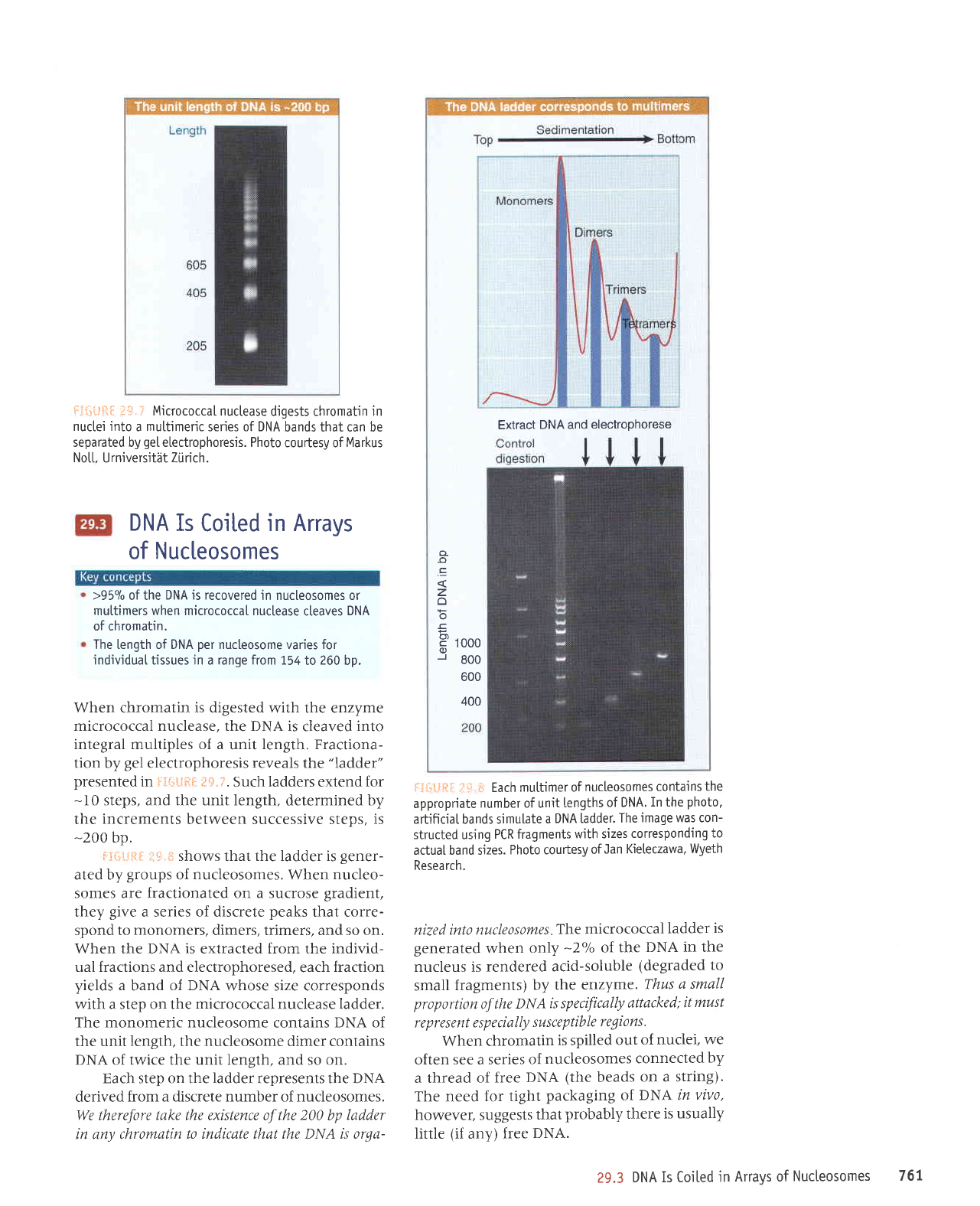
ili.i;3lf ]lS-li
MicrococcaI nuctease
digests chromatin in
nuclei into
a
multimeric
series of DNA
bands that can be
separated by
gel
etectrophoresis. Photo
courtesy of
Markus
Nott,
Urniversitdt Ziirich.
DNA
Is
Coited
in Arrays
of
Nucleosomes
>95%
of the
DNA is recovered
in nucleosomes or
muttimers when micrococcaI nuctease
cteaves
DNA
of chromatin.
The Length of DNA
per
nucteosome varies for
individual, tissues
jn
a range from 154
to
260
bp.
When chromatin is digested
with the enzyme
micrococcal nuclease, the DNA
is cleaved
into
integral multiples of a
unit
length. Fractiona-
tion by
gel
electrophoresis reveals the
"ladder"
presented
in
Fitil"jfi*
Jt3"f .
Such
ladders
extend
for
-I0
steps, and the unit length.
determined
by
the increments between successive steos. is
-200
bp.
i:i.r1ifii
i!r.it shows that the ladder is
gener-
ated by
groups
of
nucleosomes.
When
nucleo-
somes are fractionated on a sucrose
gradient,
they
give
a series of discrete
peaks
that corre-
spond to monomers, dimers, trimers, and so on.
When the DNA
is
extracted from the individ-
ual fractions and electrophoresed,
each
fraction
yields
a
band
of DNA
whose size corresponds
with
a step on the
micrococcal
nuclease ladder.
The monomeric nucleosome
contains
DNA of
the unit length, the nucleosome dimer contains
DNA
of
twice the unit length, and
so
on.
Each step on the ladder represents the DNA
derived
from a discrete number of nucleosomes.
We therefore take the existence of the 200 bp
ladder
in any chromatin
to indicate that the DNA is orga-
il?i.rll[1I
;ti].;i
Each multimer
of
nucteosomes
contains
the
appropriate
number of unit
[engths
of DNA.
In the
photo,
artjficiaI bands simulate
a
DNA ladder.
The
image was con-
structed using
PCR fragments
with sizes
corresponding
to
actuaI band sizes.
Photo courtesy
ofJan
Kieteczawa,
Wyeth
Research.
nized into nucleosomes
The micrococcal
ladder
is
generated
when
only
-2o/o
of
the
DNA in the
nucleus is rendered
acid-soluble
(degraded to
small
fragments)
by the
enzyme.
Thus
a small
proportion
of
the DNA
is specifically
attacked;itmust
represent
especially
susceptible
regions.
When chromatin
is spilled
out
of nuclei,
we
often
see a series
of
nucleosomes
connected
by
a thread of
free
DNA
(the
beads
on a string).
The need
for tight
packaging of
DNA in
vivo,
however, suggests
that
probably there
is usually
little
(if
any)
free
DNA.
Extract
DNA and
electrophorese
c
z
o
P
rooo
o
J
800
600
400
29.3
DNA Is Coiled
jn
Arravs of
Nuc[eosomes
767
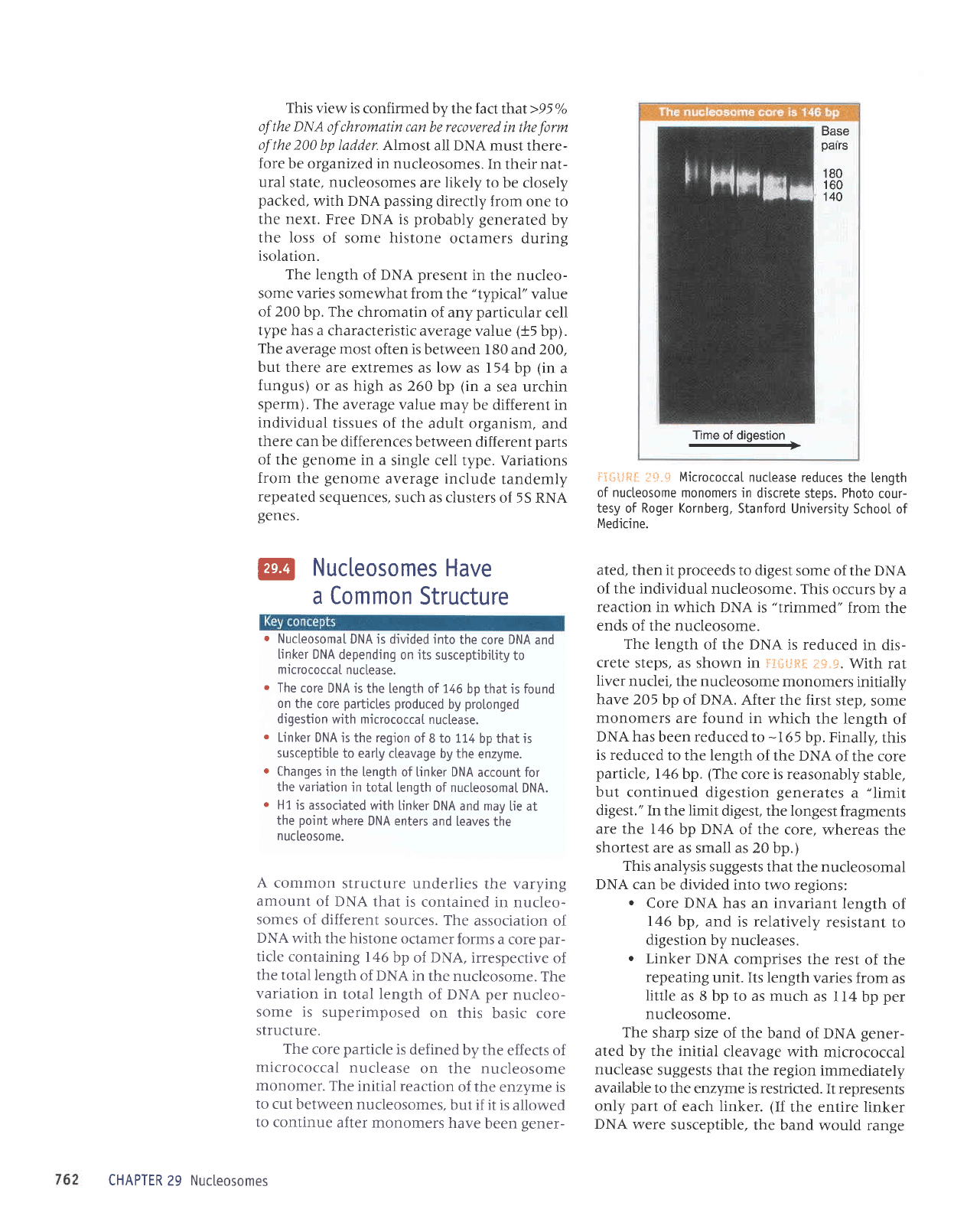
This
view is confirmed
by the fact that>95yo
0f the DNA
of chromatin can
be recovered in the
form
of the
200 bp ladder. Almost
all DNA must
there-
fore
be organized in nucleosomes.
In
their nat-
ural
state, nucleosomes
are
likely
to be closely
packed,
with DNA
passing
directly from
one to
the
next. Free DNA is
probably
generated
by
the loss
of some histone
octamers during
isolation.
The length
of DNA
present
in the nucleo-
some varies
somewhat from
the
"typical"
value
of 200
bp. The chromatin
of any
particular
cell
type has a
characteristic average
value
(+5
bp).
The
average
most often is
between 180 and 200,
but there
are extremes
as
low
as 154
bp
(in
a
fungus)
or as high
as 260 bp
(in
a sea urchin
sperm). The
average value may
be different in
individual
tissues
of the adult organism,
and
there
can be differences
between
different
parts
of the
genome
in a
single cell type.
Variations
from
the
genome
average include
tandemly
repeated
sequences,
such as clusters
of 5S RNA
senes.
@
Nucteosomes
Have
a Common
Structure
r
Nucleosomal
DNA is divided into
the
core
DNA
ano
tinker DNA
depending
on
its
susceptibiLity
to
micrococcaI
nuc[ease.
r
The
core DNA is
the [ength
of
146
bp that is found
on
the core
particles
produced
by
prolonged
digestion with micrococcaI
nuclease.
.
Linker DNA
is the region
of 8 to 71,4
bp that is
susceptibte
to early
cleavage by the
enzyme.
o
Changes
in the
length of [inker DNA
account for
the variation
jn
total
length of nucleosomal
DNA.
r
H1
is associated
with linker DNA
and may
lie at
the
point
where
DNA enters
and leaves
the
nucteos0me.
A
common
structure
underlies
the varying
amount
of DNA that is
contained
in nucleo-
somes of
different
sources. The
association
of
DNA
with the histone
octamer forms
a core
par-
ticle containing
146
bp
of
DNA,
irrespective
of
the total
length
of DNA in
the nucleosome.
The
variation
in
total length
of DNA
per
nucleo-
some is
superimposed
on this
basic core
structure.
The
core
particle
is defined
by the
effects of
micrococcal
nuclease
on the nucleosome
monomer.
The initial reaction
of the
enzyme is
to cut
between nucleosomes,
but if it
is allowed
to
continue
after monomers
have
been
sener-
CHAPTER
29
Nucteosomes
Base
parrs
180
160
140
Time
of dioestion
-.>
tgliilftl
t:1.*
Micrococcal
nuclease reduces
the
lenqth
of nucteosome
monomers in
discrete steps. Photo
cour-
tesy of Roger Kornberg.
Stanford University
School of
Medicine.
ated, then it
proceeds
to digest
some of the DNA
of the individual
nucleosome.
This occurs
by a
reaction
in which DNA is
"trimmed"
from the
ends
of the nucleosome.
The
length of the DNA
is reduced
in dis-
crete steps, as shown in
!:ttjljftf
;i*.t.
With
rat
liver
nuclei, the nucleosome
monomers
initially
have 205
bp of DNA. After the first
step.
some
monomers
are found in
which
the length
of
DNA has
been reduced to
-I65
bp. Finally,
this
is reduced
to the length
of the DNA
of the core
particle,
146bp.
(The
core is reasonably
stable,
but
continued digestion
generates
a
"limit
digest." In the limit
digest, the longest
fragments
are the 146
bp DNA
of the core,
whereas
the
shortest are
as small as 20 bp.)
This
analysis suggests
that the nucleosomal
DNA can
be divided into
two regions:
o
Core DNA has
an
invariant
length
of
146 bp, and is relatively
resistant
to
digestion by nucleases.
o
Linker
DNA comprises
the rest
of the
repeating
unit. Its
length
varies from
as
little
as 8 bp
to as much
as 114
bp
per
nucleosome.
The
sharp size
of the band
of DNA
gener-
ated by the initial
cleavage with
micrococcal
nuclease
suggests
that the region
immediately
available
to
the enzyme is restricted.
It
represents
only
part
of each linker.
(If
the entire linker
DNA
were
susceptible,
the band
would range
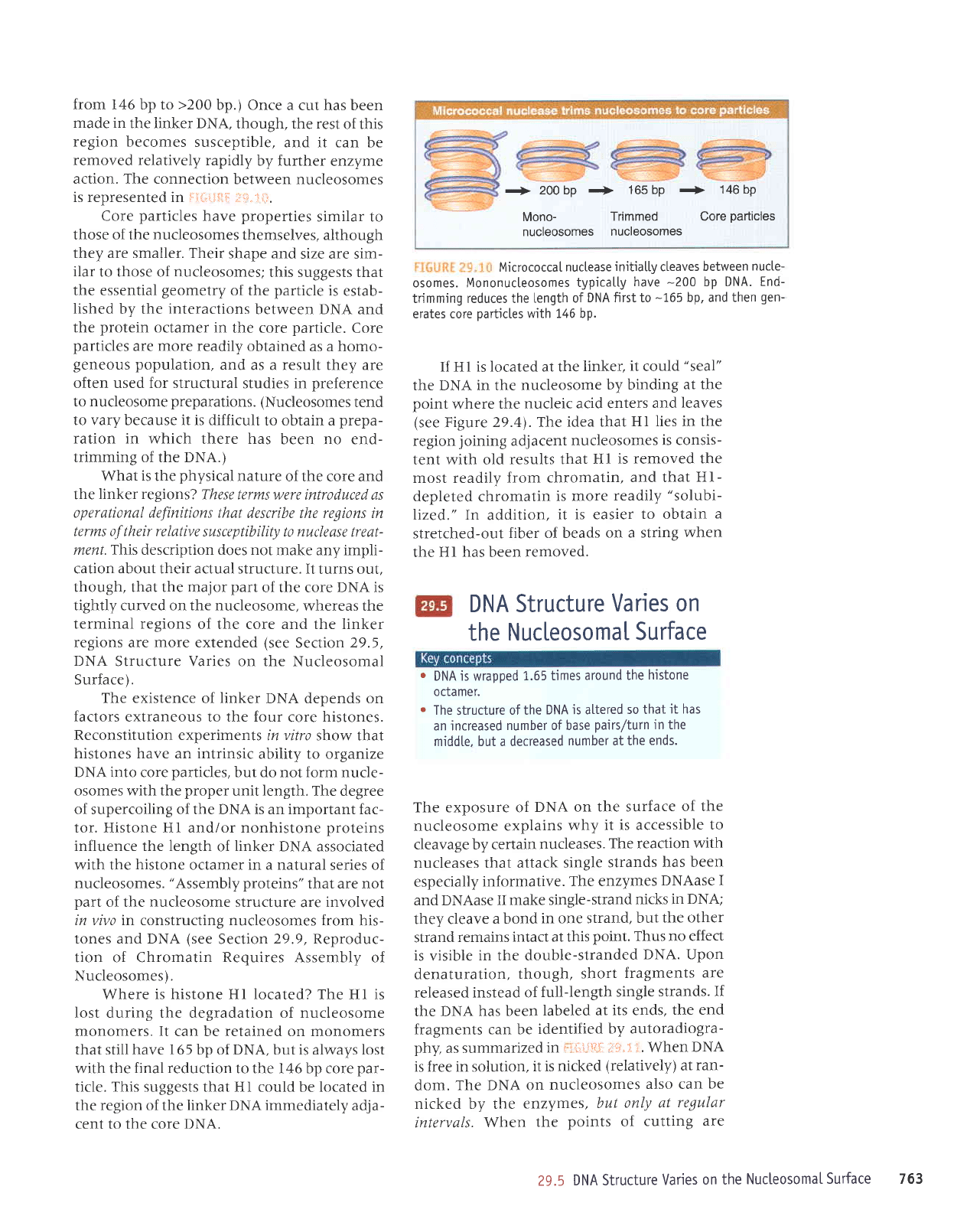
from 146 bp to
>200
bp.) Once
a cut has been
made in
the iinker DNA,
though, the rest
of this
region becomes
susceptible,
and it can be
removed relatively
rapidly
by further
enzyme
action. The connection
between nucleosomes
is represented in iili":,i-ilill ,a;i.'i
ii.
Core
particles
have
properties
similar to
those of the
nucleosomes
themselves, although
they are smaller. Their
shape and
size are sim-
ilar
to those of nucleosomes;
this suggests that
the essential
geometry
of the
particle
is
estab-
lished
by the
interactions
between DNA and
the
protein
octamer
in the core
particle.
Core
particles
are more readily
obtained as a homo-
geneous population,
and as a result they are
often used for structural
studies in
preference
to nucleosome
preparations. (Nucleosomes
tend
to vary because it is difficult
to obtain a
prepa-
ration in
which there has
been no end-
trimming of the DNA.)
What
is
the
physical
nature
of the core and
the
linker regions?
These terms
were introduced as
operational definitions that
describe the regions in
terms of their relative
susceptibility to nuclease
treat-
ment.This description does not
make any impli-
cation
about
their actual structure. It
turns out,
though, that the major
part
of the core DNA is
tightly curved on the nucleosome,
whereas the
terminal regions
of the core and the linker
regions are
more
extended
(see
Section 29.5,
DNA
Structure Varies on the
Nucleosomal
Surface).
The existence
of
linker
DNA depends on
factors
extraneous to the four
core
histones.
Reconstitution experimenls
in
vitro
show that
histones have an intrinsic
ability to organize
DNA into core
particles,
but do not form nucie-
osomes with the
proper
unit
length.
The degree
of supercoiling of the DNA is an important fac-
tor. Histone Hl and/or nonhistone
proteins
influence the length
of
linker
DNA associated
with the
histone
octamer in a natural
series ol
nucleosomes.
"Assembly
proteins"
that are not
part
of the nucleosome structure
are
involved
in vivo in constructing nucleosomes
from his-
tones and DNA
(see
Section
29.9,
Reproduc-
tion of Chromatin
Reouires
Assemblv of
Nucleosomes).
Where
is histone Hl located?
The Hl is
lost during the degradation of nucleosome
monomers.
It
can be retained on monomers
that still have 165 bp of DNA, but is always lost
with the
final reduction
to the 146 bp core
par-
ticle. This suggests that HI could be located in
the
region
of the
linker DNA immediately
adja-
cent to the core DNA.
MicrococcaI
nuctease
initiatlv
cleaves
between
nucte-
osomes. Mononucteosomes
typicatty
have
-200
bp DNA.
End-
trimming reduces the
Length of
DNA first to
-165
bp, and then
gen-
erates core
particles
with 146 bp.
If Hl
is located at the
linker,
it
could
"seal"
the DNA in the
nucleosome
by binding
at the
point
where
the
nucleic acid enters
and
leaves
(see
Figure
29.4).The
idea that
Hl lies in the
region
joining
adjacent
nucleosomes
is consis-
tent with old
results that
Hl is
removed the
most readily from
chromatin,
and that
Hl-
depleted
chromatin
is more
readily
"solubi-
lized." In
addition,
it is easier
to obtain
a
stretched-out
fiber of beads
on a string
when
the
Hl has
been
removed.
DNA Structure
Varies on
the
NucleosomaI
Surface
o
DNA is wrapped
1.65 times
around the
histone
octamer.
o
The structure of the
DNA is altered
so that
it has
an
jncreased
number of base
pairs/turn
in the
middte. but a decreased
number at the
ends.
The exposure of
DNA on
the surface
of the
nucleosome explains
why
it is accessible
to
cleavage by certain
nucleases.
The reaction
with
nucleases that attack
single
strands
has been
especially
informative.
The enzymes
DNAase
I
and DNAase II
make single-strand
nicks in
DNA;
they cleave
a bond
in one strand,
but
the other
strand
remains
intact at this
point. Thus no effect
is
visible
in the double-stranded
DNA. Upon
denaturation,
though,
short
fragments
are
released instead of
full-length
single
strands.
If
the DNA
has been
labeled at
its ends,
the end
fragments
can be
identified
by autoradiogra-
phy,
as summarized
in
r
lilijltf,
i:ii.t
:.
When
DNA
is free in solution,
it is nicked
(relatively)
at
ran-
dom.
The DNA on
nucleosomes
also can
be
nicked by the
enzymes,
but
only at
regular
intervals.
When
the
points
of
cutting
are
+
200bp
*
165bp
+
146bp
Mono-
Trimmed
Core
particles
nucleosomes
nucleosomes
29.5
DNA Structure
Varies
on the
Nucleosoma[
Surface
763
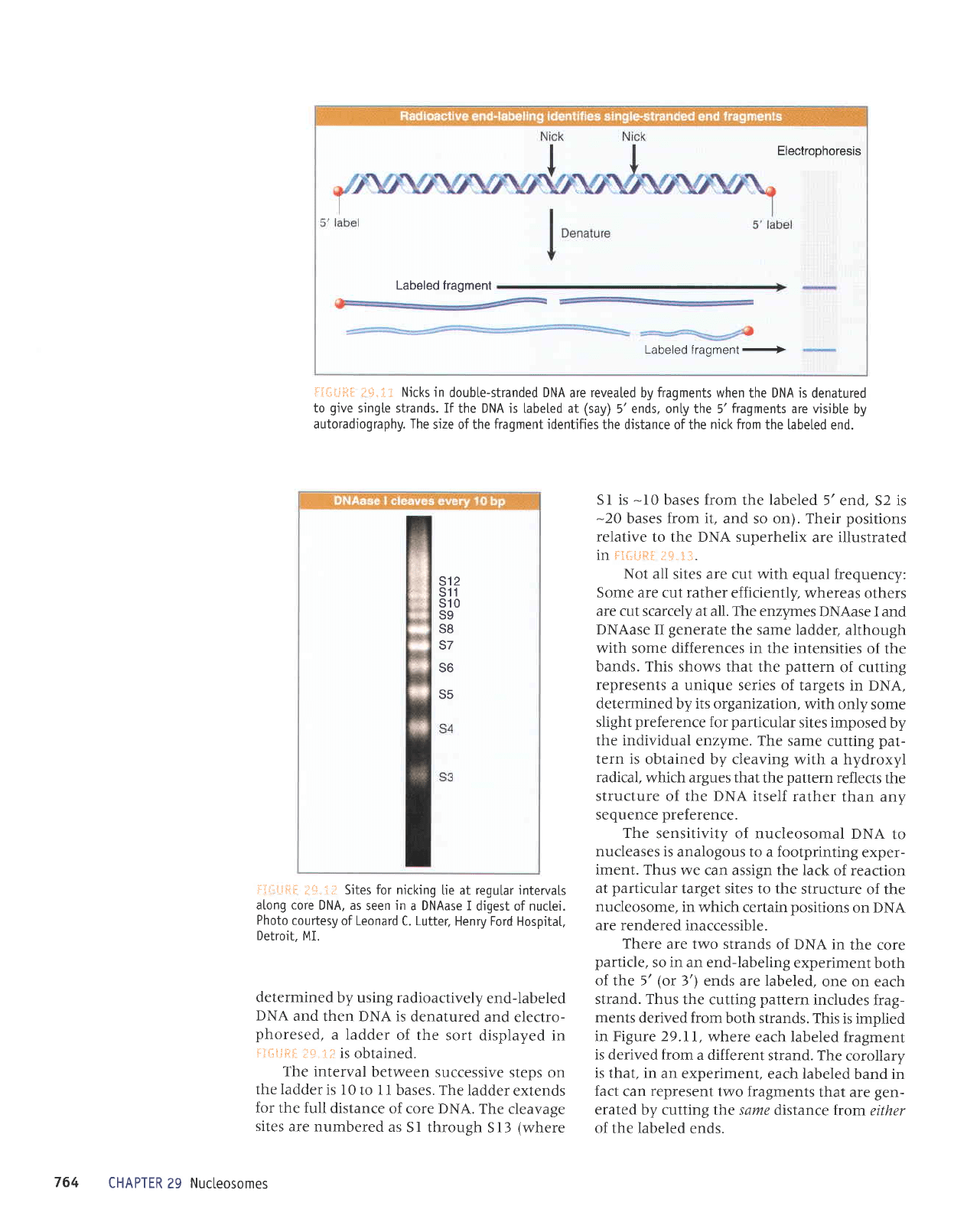
Electrophoresis
Labeled fragment
Labeled
fragment+
i::+ijiiF
l:*..1 1
Njcks in
double-stranded DNA
are
revealed
by
fragments
when the DNA is
denatured
to
give
singte strands.
If the DNA is labeled at
(say)
5'ends. on[y the 5'fragments are visible
by
autoradiography. The
size of the fragment identifies
the distance of the
nick
from the [abeled
end.
irii;t-:*.ir
;-::"i: Sites for nicking
lie at regutar interva[s
atong core
DNA, as
seen
in
a DNAase I
digest of nuclei.
Photo
courtesy
of Leonard
C.
Lutter,
Henry Ford
Hospita[,
Detroit,
ML
determined
by using radioactively
end-labeled
DNA
and
then DNA is
denatured
and electro-
phoresed,
a Iadder
of the
sort displayed in
i:ii.;F:a
l:ij..1: is
obtained.
The interval
between successive
steps
on
the ladder
is l0
to I L bases. The
ladder
extends
for the full
distance
of core DNA.
The cleavage
sites
are numbered
as
Sl through
Sl3
(where
CHAPTER
29
Nucteosomes
Sl is
-I0
bases from
the
labeled
5'end,
52 is
-20
bases
from it,
and so on). Their
positions
relative
to the DNA superhelix
are illustrated
in
F{*i.iR[:*"13.
Not all sites are cut with equal
frequency:
Some are cut rather
efficiently, whereas
others
are
cut scarcely at all. The enzymes
DNAase I and
DNAase
II
generate
the
same
ladder,
although
with some differences in the intensities
of the
bands. This shows
that the
pattern
of cutting
represents
a unique series of
targets in DNA.
determined by its organization,
with only
some
slight
preference
for
particular
sites imposed
by
the individual
enzyme. The same
cutting
pat-
tern is
obtained by cleaving
with a hydroxyl
radical,
which argues that
the
pattern
reflects
the
structure
of the
DNA
itself rather
than any
sequence
preference.
The
sensitivity of nucleosomal
DNA
to
nucleases is
analogous to a footprinting
exper-
iment. Thus
we can assign the lack
of reaction
at
particular
target sites to the
structure
of the
nucleosome,
in
which certain
positions
on DNA
are rendered
inaccessible.
There
are two strands
of DNA in
the core
particle,
so in an end-labeling
experiment
both
of
the 5'
(or
3') ends are labeled,
one on each
strand. Thus
the cutting
pattern
includes
frag-
ments
derived from
both strands.
This is implied
in Figure 29.I1,
where
each labeled
fragment
is derived from
a different
strand. The
corollary
is that, in
an experiment,
each labeled
band in
fact
can
represent
two fragments
that are
gen-
erated
by cutting lhe
same distance
hotli. either
of the labeled
ends.
s12
s11
s10
S9
S8
s7
S6
JC
764
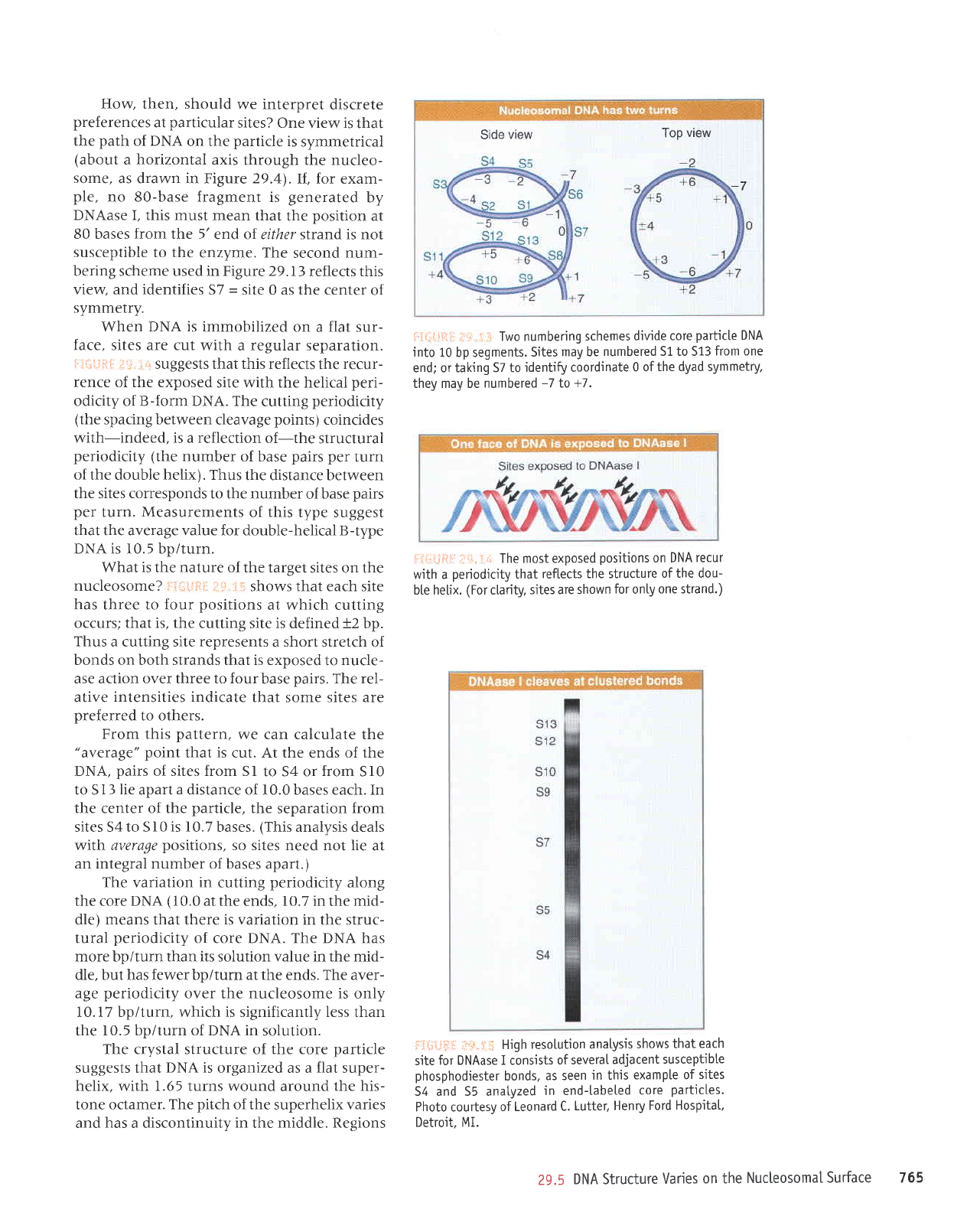
How, then, should
we interpret
discrete
preferences
at
particular
sites? One
view
is
that
the
path
of DNA
on the
particle
is
symmetrical
(about
a horizontal axis
through the nucleo-
some,
as drawn in Figure 29.4).
If., for exam-
ple,
no S0-base fragment
is
generated
by
DNAase I, this must
mean that
the
position
at
80 bases from the 5'end
of. either strand is not
susceptible to the
enzyme. The
second
num-
bering scheme used in Figure 29.13
reflects this
view, and identifies
57
=
site 0 as the center
of
symmetry.
When
DNA is
immobilized
on a flat sur-
face, sites are cut
with a regular separation.
ijltii.ii:l: ;.:i:r.
lii
suggests that this reflects
the
recur-
rence of the exposed
site with the helical
peri-
odicity of B-form DNA. The
cutting
periodicity
(the
spacing between
cleavage
points)
coincides
with-indeed, is
a
reflection
of-the
structural
periodicity (the
number
of base
pairs per
turn
of the double helix). Thus
the distance between
the
sites
corresponds
to the number
of
base
pairs
per
turn.
Measurements
of
this
type suggest
that the average value for double-helical B-type
DNA is 10.5 bp/turn.
What
is
the
nature
of the target
sites on the
nucleosome? riir\i+ii-:
;i'.i.:i r: shows that each site
has three to four
positions
at which cutting
occurs; that is, the
cutting site is defined t2 bp.
Thus
a cutting site
represents
a short
stretch of
bonds on both strands that is exposed
to
nucle-
ase action over three to four
base
pairs.
The rel-
ative
intensities indicate
that some sites are
preferred
to others.
From this
pattern,
we can calculate the
"average"
point
that is cut. At the ends of the
DNA,
pairs
of sites from Sl
to 54 or
from
Sl0
to S
I
3
lie
apart
a
distance of 10.0 bases each. In
the center of the
particle,
the
separation
from
sites 54 to S
I 0 is I
0.7 bases.
(This
analysis deals
with average
positions,
so sites need not lie
at
an integral number of
bases apail.)
The
variation
in
cutting
periodicity
along
the core DNA
(10.0
at the ends, 10.7 in
the
mid-
dle) means that there is variation in the struc-
tural
periodicity
of core DNA. The DNA has
more bp/turn than its solution value in the mid-
dle, but has fewer bp/turn at the ends. The aver-
age
periodicity
over
the
nucleosome is
only
10.17 bp/turn, which is significantly less than
the
10.5 bp/turn of DNA in
solution.
The crystal structure of the core
particle
suggests that
DNA is
organized as a flat super-
helix, with 1.65 turns wound
around
the his-
tone octamer.
The
pitch
of the superhelix varies
and
has
a discontinuity
in
the middle.
Regions
Side
view
Top
view
i'li:tii:il- 'l:i, i
:; Two numbering
schemes divide
core
particle
DNA
into 1.0
bp segments.
Sites
may be
numbered S1 to 513
from one
end; or taking 57 to
identify coordinate
0 of
the dyad symmetry,
thev mav be
numbered
-7
to
+7.
ii.ii:iiili: :i:i;j,
i n
The most exposed
positions
on DNA
recur
with a
periodicity
that
reflects the structure
of the dou-
bte hetix.
(For
ctarity,
sites are shown
for
onty
one strand.)
;iIi:i,ii-li:
;:i;,, !
-,
High
resotution anatysis
shows
that each
site
for DNAase I consists
of severaI
adjacent
susceptibte
phosphodiester
bonds,
as seen
in this
exampte of
sites
54 and S5 anatyzed
in end-tabeted
core
particles.
Photo courtesy
of Leonard
C.
Lutter.
Henry Ford
Hospitat.
Detroit, MI.
29.5
DNA Structure
Varies
on the
Nucteosomal
Surface
765
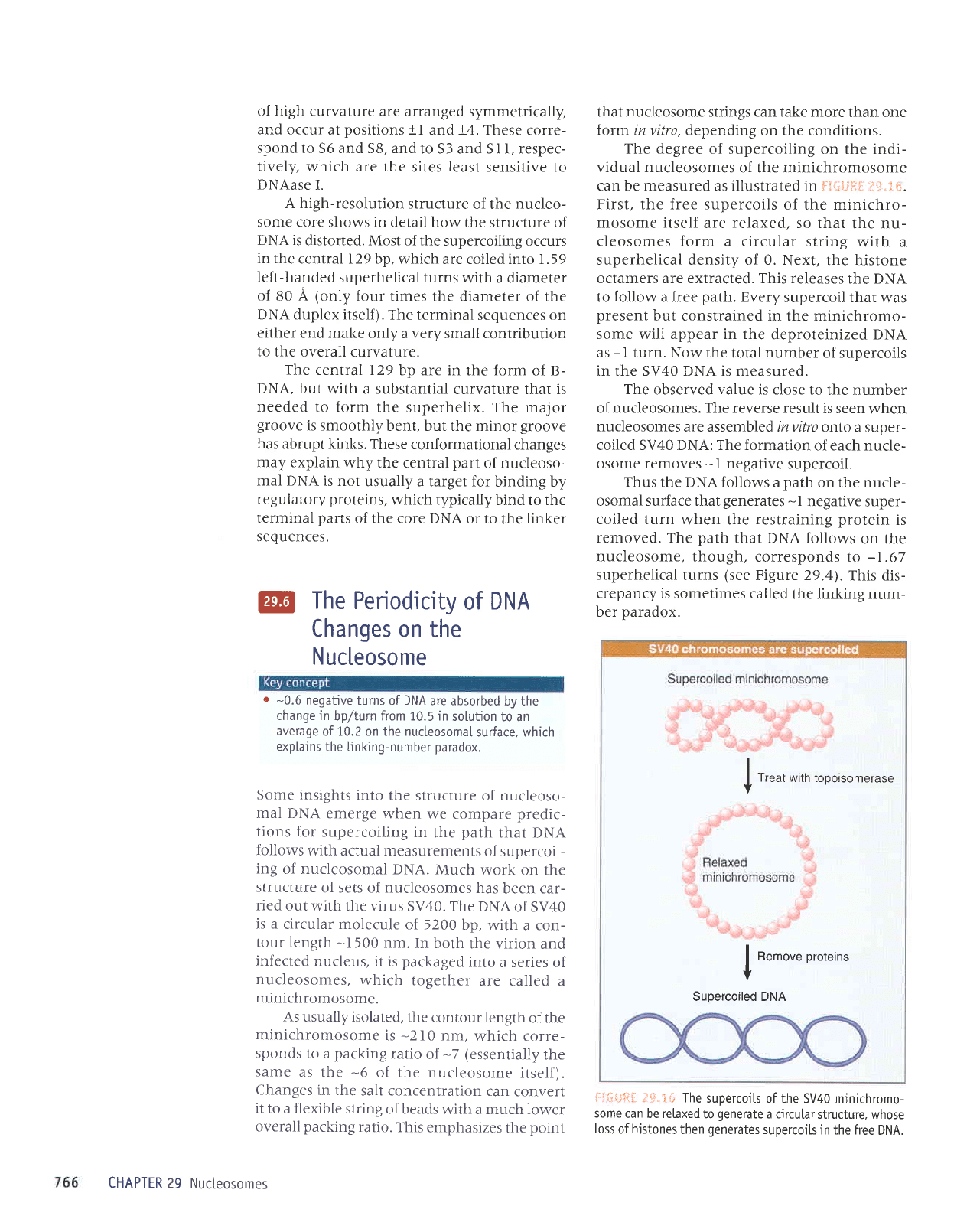
@
The
Periodicity
of
DNA
Changes
on the
Nuc[eosome
o -0.6
negative
turns of DNA
are absorbed
by the
change in
bp/turn from 10.5 in
solutjon
to an
average
of 10.2 on the nucteosomaI
surface. which
explains
the [inking-number
paradox.
Some
insights into
the structure
of nucleoso-
mal DNA
emerge
when we
compare
predic-
tions
for supercoiling
in
the
path
that DNA
follows
with actual measurements
of supercoil-
ing
of nucleosomal
DNA.
Much
work on the
structure
of sets of nucleosomes
has
been car-
ried
out with
the virus SV40.
The DNA
of SV40
is a
circular molecule
of 5200
bp, with
a con-
tour length
-1500
nm.
In both
the virion
and
infected
nucleus,
it is
packaged
into
a series of
nucleosomes,
which
together
are called
a
minichromosome.
As
usually isolated,
the
contour length
of the
minichromosome
is
-2
l0 nm,
which
corre-
sponds
to a
packing
ratio
of
^-7
(essentially
the
same
as the
-6
of
the nucleosome
itself).
Changes
in the
salt concentration
can
convert
it
to a flexible
string
o{ beads
with a much lower
overall
packing
ratio.
This
emphasizes
the
point
CHAPTER
29 Nucteosomes
that nucleosome strings can take more
than one
f.orminvitro, depending on
the conditions.
The degree
of supercoiling on the indi-
vidual nucleosomes
of the minichromosome
can be
measured
as illustrated in
ft{ilJft*
!l$.11 *.
First, the free supercoils
of the minichro-
mosome itself
are
relaxed,
so that
the nu-
cleosomes form
a circular string
with a
superhelical density of 0.
Next, the histone
octamers are extracted. This releases
the DNA
to
follow
a free
path.
Every
supercoil that
was
present
but constrained in the minichromo-
some wili appear in the
deproteinized DNA
as
-l
turn.
Now
the
total
number
of supercoils
in the SV40 DNA is measured.
The
observed
value
is close
to the number
of nucleosomes. The reverse result
is seen
when
nucleosomes
are assembledinvitro
onto a super-
coiled SV40 DNA: The formation
of each nucle-
osome removes
-l
negative
supercoil.
Thus the DNA follows
a
path
on the nucle-
osomal surface that
generates
-l
negative
super-
coiled turn
when the
restraining protein
is
removed.
The
path
that DNA
follows
on the
nucleosome,
though, corresponds
to
-1.67
superhelical
turns
(see
Figure 29.4).
This dis-
crepancy is sometimes called
the linking num-
ber
paradox.
of high curvature
are arranged symmetrically,
and occur
at
positions
+l
and
+4.
These
corre-
spond
to 56 and S8, and
to 53 and SI l, respec-
tively,
which are the
sites
least
sensitive to
DNAase
I.
A high-resolution
structure
of the nucleo-
some
core shows in detail how
the structure of
DNA is
distorted. Most of the
supercoiling occurs
in the
central 129 bp, which
are coiled into 1.59
left-handed
superhelical turns
with a diameter
of
80
A
(only
four
times the diameter
of the
DNA duplex itself
).
The terminal
sequences on
either
end make
only a very small contribution
to
the overall
curvature.
The central 129
bp are in
the
form
of B-
DNA.
but
with a substantial
curvature that is
needed
to form the
superhelix. The major
groove
is smoothly
bent, but the minor
groove
has
abrupt kinks.
These conformational
changes
may explain
why the
central
part
of nucleoso-
mal DNA
is not
usually a target for
binding by
reguiatory proteins,
which typically
bind to the
terminal
parts
of the core
DNA or to
the
linker
sequences.
I
I
Remove
proteins
i
Supercoiled DNA
I
I
Treat
with topoisomerase
FJ{itJ}Jfl
tg".'r{:: The
supercoils
of the SV40 mjnichromo-
some
can be retaxed
to
generate
a cjrcutar
structure,
whose
loss
of hjstones
then
generates
supercoi[s
in the free
DNA.
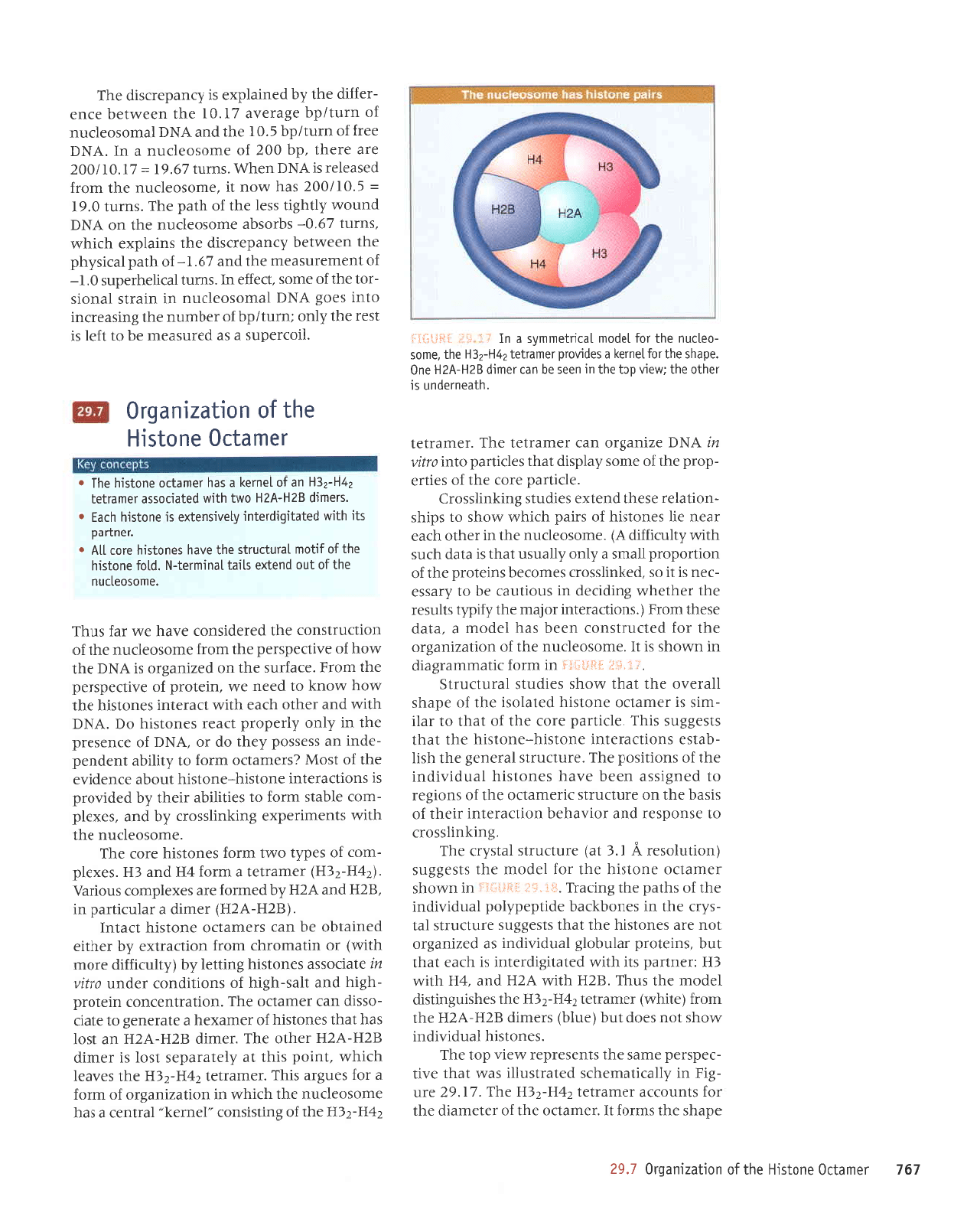
L9L
rauepo auolsrH aqlJo
uoqezluefuo
L'62
Jdeqs
Jql suroJ
lI
'Jarxepo
eqt
Jo
JJlJruprp
eql
roJ slunoJJE J3ruprlat
ZVH-T€H
aqJ
'/
I
'62
eJn
-3lg
ul
,{.llerrteruaq)s
pelerlsnilr
se,r,t
teqt
eAIl
-radsrad
erues aql sluasardar.lzran dol aq1
'seuolsIq
IenpIAIpuI
Moqs
tou
seop
tnq
(an1q)
sraurp
gZH-VZH
aql
uror;
(arqu)
rJuprlet
lVH-z
€Haqt
saqsrn8ultstp
Iaporu
rql snqJ
'gzH
qllM
vzH
pue
'tH
qll1l{
gg
:rauged
stl
qllM patelfrpratur
sr
qJeJ
teql
1nq
'suralord
relnqop
lenprlrpu
se
pazrueS:o
lou
JJp sauolsrq Jql
leqr
slsaSSns eJnlJnrls
Ipl
-s,{.n
aql uI seuoq>lJeQ apltdad,ilod
lenprntput
aqt
yo
sqted aqt SuoerJ
'.iit'i
il :irt:{ii,i:,1
uI
uMoqs
Jerrrel)o Juolsrq eql JoJ
Iepou
aql
slsaSSns
(uorlnlosar
y
I'S
le)
eJnlf,nns
1e1sLn
aq1
'tsur>IUIISSOJJ
ol asuodsar
pue
JoIAeqJq uollJeJalul
JIJq]
Jo
srspq Jql uo JJnlJnrls JrrJruelJo aql;o
suor8ar
o1
pau8rsse
uaJq enpq sJuolslq
IpnpI^IpuI
Jqt
Jo
suortrsod aq1
'JJntJnJts
lerauaS
Jq1
qsll
-qPlSJ
SUOrlJerJlUr auolsrr{-Juorsrq
eql
]eql
s1sa33ns srql
'allrupd
aror aqt
Jo
tpql
ot
JelI
-rurs
sr JJurPlJo Juolsrq
pJlPlosr
aqt
;o
adeqs
IIPJa^o
aql
lPql
l!\or{s sJrpnls
IeJnl)nJls
',:
i.'i!r:
.+llU$i.-l
uI uIIoI
rtleruruer8elp
ur uMoqs
sl
1I
'JruosoelJnu
Jql
1o
uotleztueSro
Jql JoJ
pelJnJlsuoJ
ueaq spq
lJpotu
e
'Plep
JSJqt ruor{
('suorperalur
roleru aqt riyrddt
sllnsJr
aril JJqlaqM Surpnap ur snorlneJ
aq o1
,(ressa
-Jau
sr
ll
os
'pJ>lurTSsoJJ
sJruo)Jq sulatord
aqt;o
uoruodord
fierus
e
,(1uo Llensn
teql
sr e]ep
qJns
qrpn,ltlnrryyrp
y)
'aruosoapnu
eql uI
rrqlo
qf,Pe
reJu
JII sJuotsrq
yo
srred
qJIqM .troqs o1 sdtqs
-uorleleJ
eseql
puelxJ
sJrpnls
3ur>1ur1ssor3
'apured
eJot
Jqt
Jo
sJlua
-dord
aqt;o aruos
,{.e1dsrp
teqt
saprued olur
lJit^
/ll
VNO
azrue8ro ueJ JJruerlel eql
'reuellJl
'qlPeulapun
st
raqlo
aql
lMet^ dol eql ur u00s 0q uel raurp
BZH-vzH
eu0
'edeqs
aq1
ro1
1aure1
e sepL'rord .lourp.llal
zrH-zEH
aql
'eulos
-oolrnu
oql lo1
lopour leruleuufs
e u1
: ];ii'iil]i:l
zVH-|€Haql;o
SupsrsuoJ
,,lauJJ>1,,
IerlueJ
P seq
eurosoJlJnu
Jql
qJIqM
ul uollezlueSro;o
urrol
e roy sanSre
srql'Jeluert
al
epll-z
g11
aq1 seneel
qJIqM
'1urod
slql
le
[lateredas
lsol
sI
Jeulp
flzH-vzH
raqlo aqJ'rsrulp
szH-YZH
ue
lsol
seq
teql
sauotslr1
Jo
JJIupxJq
e aleraua8
01 JIeIJ
-ossrp
ueJ JJureDo
aqJ
'uonprluaJuo)
uralord
-q8rq
pue
rles-q8tq
Jo
suolllpuoJ
rJpun 04a
zr ater)ossp
seuotslq
3u11a1
Lq
(fuprqyp
aroru
qfl^azr)
ro ullPruoJq)
ruoJJ uollJPrlxa
zlq rJI{]lJ
paurplqo
eq
ueJ sJauretJo
auolslV
1le1ul
'(AZH-VZH)
reulp
e relnrrged
ur
'g1Hpueyzll
^dq
paurro;
are saxaldruoJ
snolre1
'(lVtl-r*t)
Jeruprlel
p
uroJ
7H
pup
911
'saxald
-ruoJ
Jo
sadrh
o^4,r1 tuJoJ
seuolslq
eJoJ JqJ
'eluosoalJnu
Jql
qtlm
sluJrulradxa
SutlullssoJ)
.{q
pue
'saxald
-uo)
alqets
ruJoJ
01 sJIlITIqe
rraqt
,(q
paprrrord
sr suorlJeJJlur
Juolslq-Juolslq
lnoqe
eJuapIAJ
Jq1
Jo
tsow
ZsJeruet)o
IUJoJ
01
,{.l11qe
luapuad
-Jpur
ue ssassod,{aqr
op Jo
'YN(
1o
aruasard
eqt
ur Lluo
.{.padord
trear
sJuotslq
oC
'VNo
qll^\
pue
Jeqlo
qJea
qll^\
Deralul
sauolslq aql
.&|Oq
Mou>l 01
pJau
a,u
'ura1oJd
yo
an4radsrad
eql
ruoJd
'Jf,eJJns
Jql
uo
panueSro
sI
vN(
Jql
Moq
Jo
arruradsrad
aql uorJ
elrrosoJlJnu
Jql
Jo
uorl)nrlsuoJ
aql
pJrJpISuo)
e^eq
31!\ JeJ
snqJ
'eulosoaltnu
aql
J0
lno
puolxe sltP]
lPutullal-N
'ploJ
euolstq
aql
J0
Jtlolll
lPlnpnlls
aql a^eq
sauolstq
elol
llv
.
'lau1lPo
sl!
ql$ palelrbrpralut filanLsualxa
st auo]sttl
Lllel
r
'seurp
8zH-vzH
oMl
qlm
palPtlossP
lauPllol
zrH-zEH
ue
Jo laural
e seq raurello
auo]stt{
aLll
r
Jauello
auolstH
aql
Jo
uoqezruP6r0
'1tor-radns
e se
pernseau
aq
ol
Uel
sI
lsJJ
eqt.{po
1urn17dq
Jo
Jaqlunu
Jql SuISParJuI
olur
sao8
VNq
leurosoJl)nu
uI
uleJls
IPUoIS
-rot
aqt
Jo
euos
'DaJJa
uI
'srunl
leJlleq.radns
6'1-
Jo
tuaruJrnspau
eql
pue
49'I-
Jo
qted prtsdqd
Jqt
ueJ,lrtJq,{tuedanstp
aql
sureldxa
qJILIM
'suJnl
49'0-
sqJosqe
JruosoJlJnu
Jq1 uo
vN(I
punoM,{pq31r
ssrl aqt
lo
qled
rqJ'surnl0'6I
=
S'0I/002
sPq
Mou
1l
'euosoelJnu
eql
IUOJJ
pasPrlar
sl
VNO
ueq^A'surnl
49'6I
=
LI' 0I l00e
Jrp arJqt
'dq
OOZ
Jo
eluosoepnu
e uI
'YNQ
eJrI
Jo
urnlTdq
E'0 I
aqt
pue
VN(
IeIuosoJIJnu
1o
urnlTdq
JBpJeAe
ZI'0I
eql
uJemleq
aJue
-rJJIIp
aqt ,(q
paureldxa sr
druedaDslp
JqI
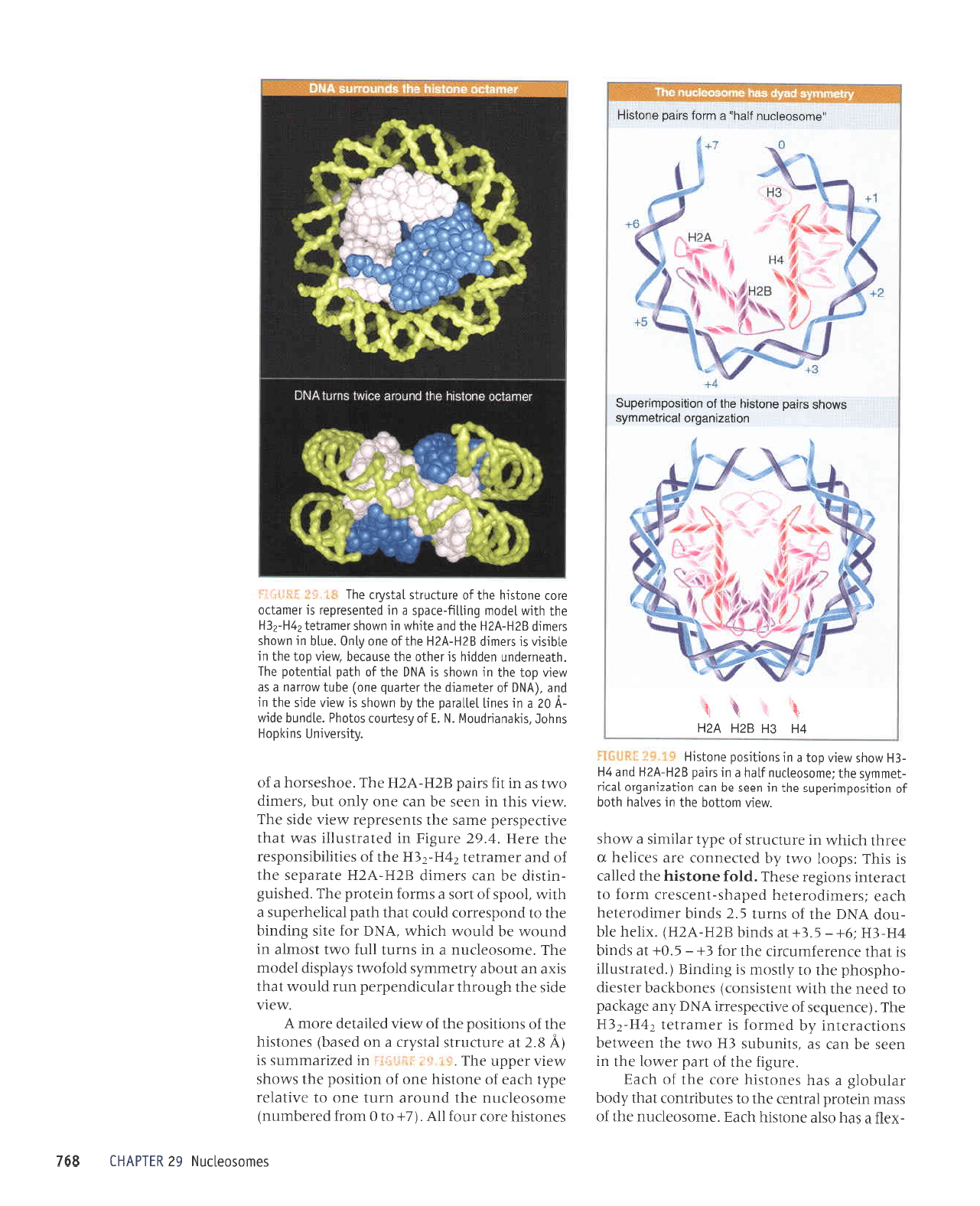
-xalJ
P
seq osle
Juotsrq
qJeE
'JtuosoalJnu
Jql
Jo
ssPlu
urJtoJd
IeJluJJ
Jql o1 sJlnqrJtuo)
]eq]
^poq
JelnqolS
p
seq sJuolsrq
JJof, Jql
Jo
q)pg
.JlnSrJ
Jql
Jo
ued
JJMOI
Jql ur
ueJS eq ueJ
se
'sllunqns
€H
oMl Jql
uaJMlJq
suoIlJeJJluI
^q
paruloJ
sr JJurerlat
|VH-|{.H
aq1
'(aruanbas;o
a,rrnadsJrJr
VN(
Lue a8eped
ol
pJJu
Jqt
qtrM
tuJlsrsuo))
sJuoq>lJeq
ralsJrp
-oqdsoqd
aqt
or Lltsoru
sr
Surpurg
('paterrsnllr
sr
]eq]
JJuJJeJrrrnJJrJ
Jql JoJ
€+
-
S'0+
1e
spurq
tH-€H
:9+
-
S'€+
le
spurq
AZH-yZH)
'xrrrrl
rlq
-nop
vN(I
eqt
Jo
sulnl
s'z
spulq
rrrulporelJq
qJee
lsraurrpoJJlJq
padeqs-luarserJ
ruJoJ ol
lJeJatur
suor8ar
JSJqJ'pIoJ
auolsrq
aql
pJIIeJ
sl slql :sdoo1
o,r,r1
Lq
panauuoJ
eJe sJf,rlJq
n
JJrql qJIqM
ur ernlJnJls
yo
ad,{1 Jplrurrs
e
Moqs
'Mar^
uolloq
aql ur sa^leq
qloq
;o
uoLlLsoduuadns
eq1 ut
uaas aq uer
uorlezLuebro
leru
-1aLuufis
eq] iauosoallnu
Jleq
e ur srLed
g7g-y711
pue
79
-tH
Moqs nneLn
do1
e uL suorlLsod
auolsrH
.
soruosoallnN
6z
ulldvHl
sJuolsrq
Jrol rnoJ
IIv
'(Z+
ot
0
uroJJ
paraqrunu)
aurosoJlJnu
Jql
punoJe
uJnl Juo 01
JAIIeJJJ
ad.,{r
qrBa
Jo
Juotsrq Juo
Jo
uorlrsod
Jqt suor{s
aaatn faddn
JQI
':,
r
':rr
rJ*r'-:iri
uI
pJZIJeuIuInS
SI
(y
s'z
re
JrnrJnrls
1elsln
e uo
paseq)
sauotsrrl
Jql
Jo
suortrsod
aqt
Jo
,trerl
pJlretep
aJotu
V
.MEIA
epls
aql
q8norql
relnlpuadrad
unr
p1no,r,r
1eq1
srxe
ue
tnoqB
L"rtauru.{s p1o;o.,r,rt
s.{eldsrp
Iepotu
eqJ
'JruosoalJnu
e
ur suJnl
IInJ
oMl
lsolule
ur
punou
rq
plnou
qtlr{M
'VNO
roJ
alrs Surpurq
Jql
ot
puodsarJo)
plnoJ
teqt
qted
IeJrTJqJedns
e
qtrar
'1oods
Jo
uos
p
suroJ uratord
aql'paqsrn8
-unsrp
Jq ueJ sJJturp
SZH-V7H
aleredas
aql
Jo
pue
JJruprlJt
zVH-.€H
Jqt
Jo
sJrlrlrqrsuodsar
Jql eJJH
'y'67
etn?r.g ur
pJtprlsnllr
seM
teql
arrttradsrad
aups Jql
sluasardar Mar^
Jprs JqJ
',r,t.Jrl
srql ur UJJS
Jq up) auo Lluo
lnq
'sJaurp
o.Ml se u1
trl
srred
fJzH-yzH
JqJ
'JoqsJsroq
p
Jo
'filLsranrul
surldop
suqo['sr)pueupno1ir1
'N
'3
1o
fiselnor
soloqd
'alpunq
aprm
-V
0Z
P u! sautl
lelleled
aq1
[q
unnoqs st Mat^
oprs aql ur
pire
'(VtrtC
Jo
relauprp
eq1 talenb auo)
aqnl
Moilpu
e sp
maLn
do1 aql ur uMoqs
s!
VN6
aql
1o
qled
lequalod
aq1
'qlpaulapun
uapprq sr leqlo
aq] asnelaq
'nneLn
do1 aq1 ut
alqrsr^ sr
slaurp
BZH-VZH
oqlJo auo r{1ug'enlq
ur uMoqs
s.rautp
BZH-VZH
oql
pue
alrqM ut u/v\oqs leuelJal
zrH-ztH
aql
qllM
lapoLu
6uq1g-ereds
e uL
paluasetdet
sr
lauelto
a.lol auolsrq
aql
Jo
ainllnlls
1e1s&t
eql
I !:
891
VH EH
BZH VZH
't
1*
uollezrueblo
;eculeutuAs
smor1s sJted
euolstq
eql
1o
uorlrsoduuedng
,,euosoalcnu
lleqr
e uilol
slred euoistH
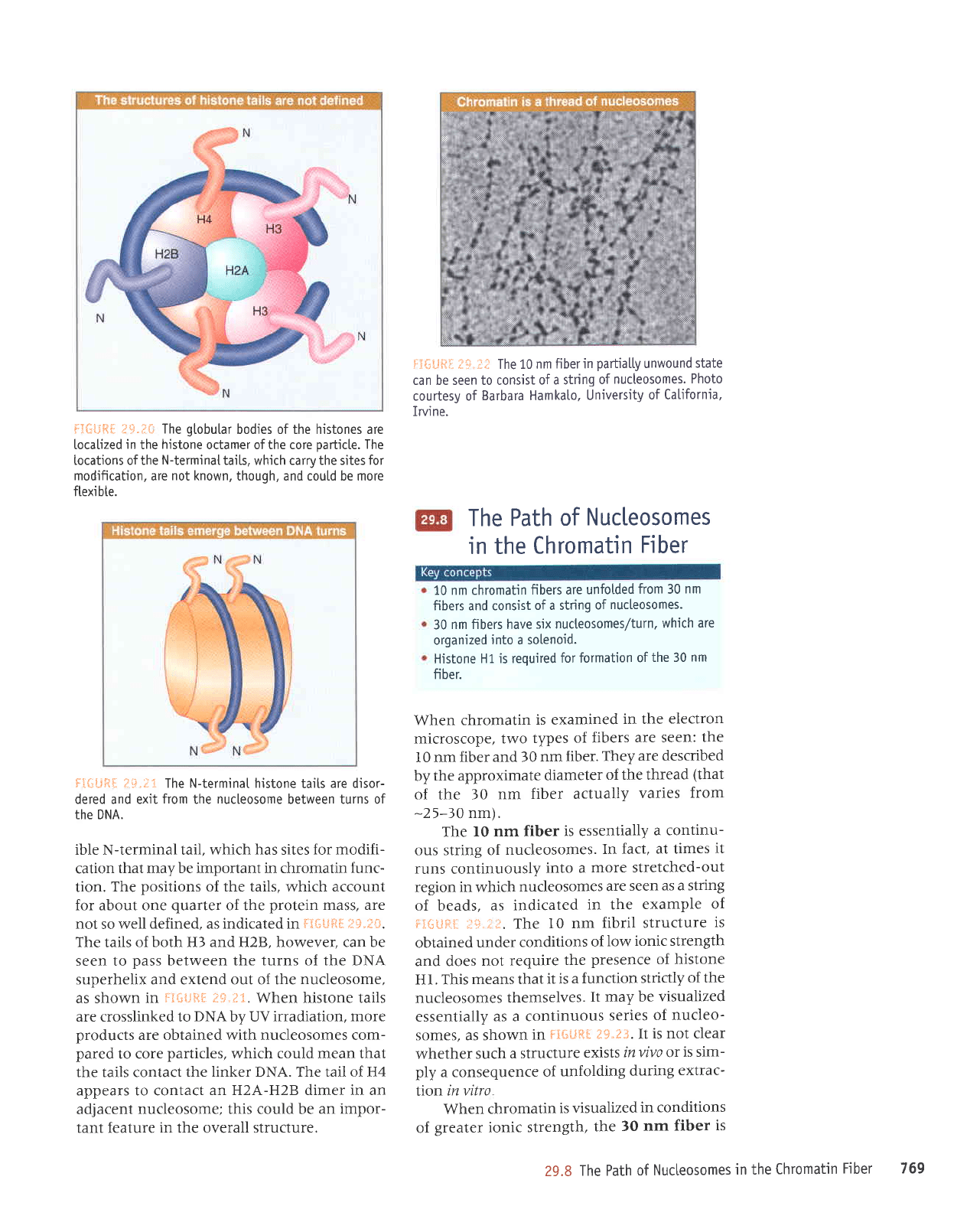
FI#ilf{il J#"f* The 10 nm
fiberin
partiatty
unwound
state
can be seen to consist
of a string
of
nucteosomes.
Photo
courtesy of
Barbara Hamkato.
University
of Catifornja,
Irvine.
FI*i.!fiil iit"ti The
gtobutar
bodies of the histones are
locatized
in
the
histone
octamer of the core oarticte.
The
locations ofthe
N-terminal
taits, which carry the sites for
modification,
are
not
known, though, and coutd be more
ftexi bte.
'tn
f,:*tifril
3*.I1 The N-terminaI histone
taits
are disor-
dered and exit
from
the
nucleosome
between turns of
the DNA.
ible N-terminal tail, which
has
sites
for modifi-
cation
that may be important in chromatin
func-
tion.
The
positions
of the tails, which account
for about one
quarter
of the
protein
mass, are
not
so well
defined, as indicated in
Ff
tltiftS
f $.f
.
The
tails
of both Hl and H2B, however. can be
seen to
pass
between the turns of the DNA
superhelix and extend out of the
nucleosome,
as shown
in
ill*u$i* ;l*.f 1.
When histone tails
are crosslinked to
DNA
by UV
irradiation, more
products
are obtained with nucleosomes com-
pared
to core
particles,
which could mean that
the tails contact
the linker DNA. The tail of H4
appears to contact
anH2A-H2B dimer in an
adjacent
nucleosome; this could be
an impor-
tant feature
in
the overall structure.
The Path
of
Nucleosomes
the
Chromatin
Fiber
10 nm chromatin
fibers are
unfotded
from 30
nm
fibers and consist
of a string
of
nucleosomes.
30
nm fibers have
six nucteosomes/turn,
which
are
organized
into a sotenoid.
Histone
H1 is required
for formation
of
the 30
nm
fiber.
When chromatin
is examined
in the
electron
microscope, two
types
of fibers
are seen:
the
l0 nm fiber
and f 0
nm
fiber. They
are described
by
the approximate
diameter
of the thread
(that
of the 30
nm
fiber actually
varies
from
-25-30
nm).
The
l0 nm fiber
is essentially
a continu-
ous string of
nucleosomes.
In fact,
at times
it
runs
continuously
into
a
more stretched-out
region
in
which
nucleosomes
are
seen
as a string
of beads, as
indicated
in the
example
of
F5*ljtril
t+.;i;]. The
I0 nm
fibril structure
is
obtained
under
conditions
of
low
ionic strength
and does
not
require
the
presence of histone
HI. This
means that
it is
a function
strictly
of the
nucleosomes
themselves.
It may
be visualized
essentially
as a continuous
series
of nucleo-
somes, as shown
in
flI{i{JF't
il'S.!.$. It
is not clear
whether
such
a structure
exists
invivo or
is sim-
ply
a consequence
of
unfolding
during
extrac-
tion
in vitro
When
chromatin
is
visualized
in conditions
of
greater ionic strength,
the
30 nm
fiber
is
29.8
The Path
of Nucleosomes
in the
Chromatin
Fiber 769
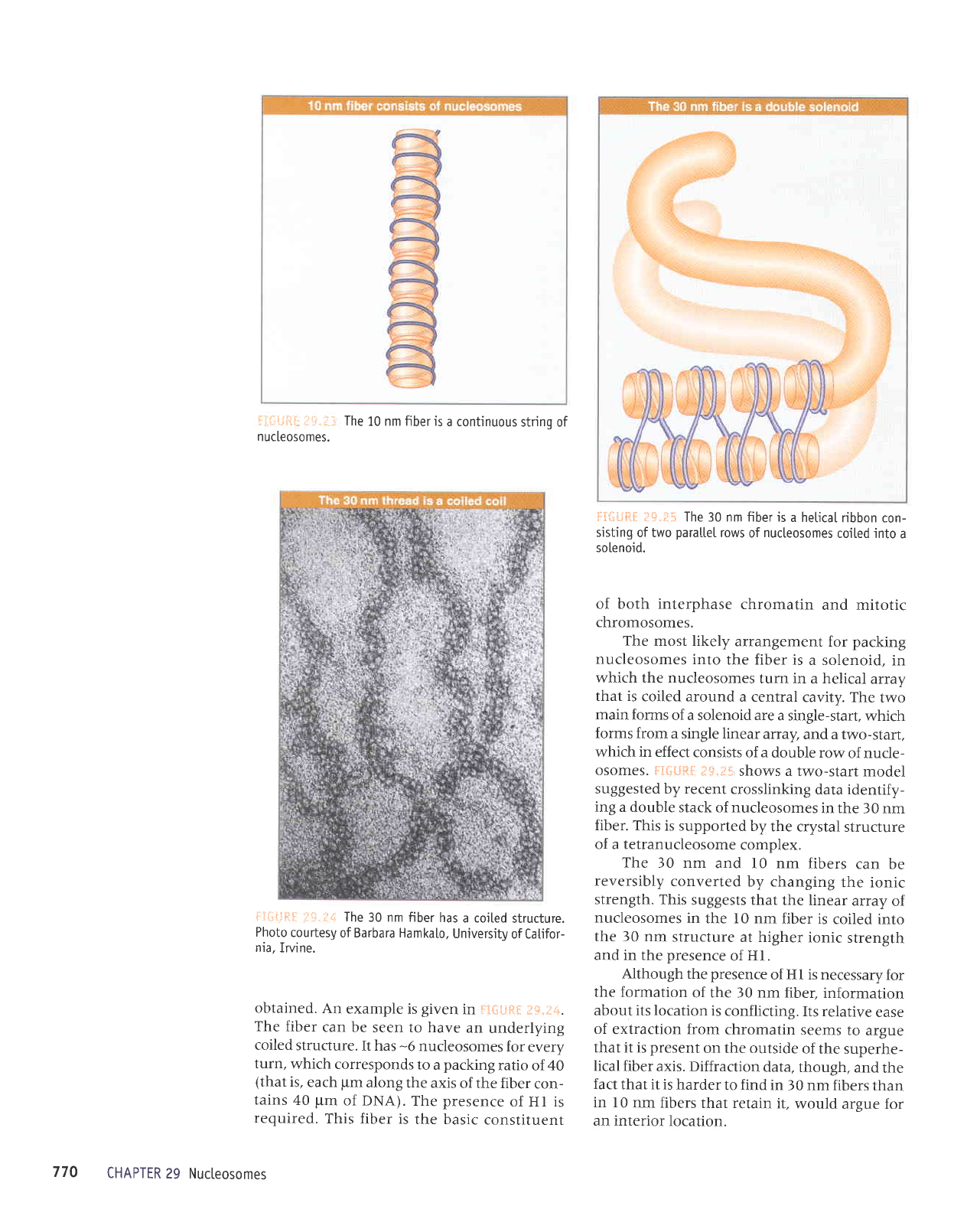
iji,l;iti
i;":i.:::::
The
10 nm fiber is
a continuous
strinq of
nuc[eosomes.
i:iiiiii:i .il.f
+
The
30 nm fiber
has
a coited
structure.
Photo
courtesy
of Barbara
Hamka[0.
University
of Catifor-
nia,
Irvine.
;l'J',ir"s;
*T:l?T
;t',""i':i
ff :Li;,il;
coiled
structure.
It has
-6
nucleosomes
for
every
turn,
which
corresponds
to
a
packing
ratio
of
40
(that
is,
each
pm
along
the axis
of the fiber
con-
tains
40
pm
of DNA).
The
presence
of Hl is
required.
This
fiber is
the basic
constituenr
CHAPTER
29 Nucteosomes
i*l*tJF.[
i]$"il:i The 30 nm fiber is
a heticaI
ribbon con-
sisting
of two
parattel
rows
of
nucteosomes
coited
jnto
a
solenoid.
of both interphase
chromatin
and mitotic
chromosomes.
The most likely
arrangement
for
packing
nucleosomes
into
the fiber is
a solenoid,
in
which the nucleosomes
turn in a helical
array
that is
coiled around
a central
cavity. The
two
main
forrns
of a solenoid are
a single-start, which
forms
from a single
linear array,
and a two-stan,
which in effect
consists of a
double row
of nucle-
osomes. eI*{.:ff*
;S.il$
shows a two-start
model
suggested by recent
crosslinking
data identify-
ing a double
stack of nucleosomes
in the
30 nm
fiber.
This is supported
by
the crystal
structure
of a tetranucleosome
complex.
The
30 nm
and l0 nm
fibers
can be
reversibly
converted
by changing
the ionic
strength.
This
suggests that
the linear
array
of
nucleosomes
in
the l0 nm
fiber is
coiled
into
the 30 nm
structure
at higher
ionic
strength
and in the
presence
of Hl.
Although
the
presence
of Hl is necessary
for
the formation
of the l0 nm fiber,
information
about its
location is
conflicting.
Its relative
ease
of
extraction from
chromatin
seems
to
argue
that it is
present
on the outside
of
the superhe-
lical
fiber axis.
Diffraction
dara,
though,
and
the
fact
that it is
harder
to find in
30 nm fibers
than
in l0
nm fibers
that retain
it,
would
argue for
an interior
location.
770
